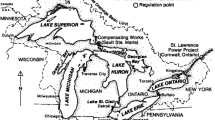Abstract
Windermere, the largest lake in England, seldom freezes over but the sheltered bays are usually covered with ice for several days every year. Here I analyse the meteorological factors influencing the development of ice on the lake between 1933 and 2000 and relate these to the regional and global changes in the weather. The results demonstrate that the methods used to describe the development of ice at high latitudes can also be used to predict the formation of ice on this temperate lake. The best indicator of change was the number of ice-days recorded every winter. Regression analyses based on a Poisson model showed that there were significant negative correlations between the number of ice-days and the local air temperature, the Central England Temperature and the North Atlantic Oscillation Index (NAOI). The relationship with the NAOI was particularly pronounced and explained 50% of the observed inter-annual variations. A hindcasting model based on the NAOI correctly predicted the most severe winters reported in the area between 1864 and 1910. The observed and predicted numbers of ice-days were also correlated with an index of sea ice in the Baltic. The results demonstrate that the number of ice-days reported on Windermere} can be used as a proxy indicator of climate change and show that the NAO has had a major effect on the development of ice on this lake for at least a hundred and thirty years.
Similar content being viewed by others
References
Adrian R, Hintze T (2000) Effects of winter air temperature on the ice phenology of the Müggelsee (Berlin, Germany). Verh Internat Verein Limnol 27:2808–2811
Anderson WL, Robertson DM, Magnuson JJ (1996) Evidence of recent warming and El-Nňio-related variations in ice breakup of Wisconsin Lakes. Limnol Oceanogr 41:815–821
Chen D, Li X (2004) Scale-dependent relationship between maximum ice extent in the Baltic Sea and atmospheric circulation. Glob and Planet Change 41:275–283
Assel RA, Robertson DM (1995) Changes in winter temperatures near Lake Michigan, 1851–1993, as determined from regional lake-ice records. Limnol Oceanogr 40:165–176
Davies TD, Viner D, Jones PD (1997) Changes in atmospheric circulation and climate over the North Atlantic and Europe. In: George DG, Jones JG, Puncochar P, Reynolds CS, Sutcliffe DW (eds) Management of Lakes and Reservoirs during Global Climate Change. NATO ASI Series, Kluwer, Dordrecht, pp 1–13
Hurrell JW (1995) Decadal trends in the North Atlantic Oscillation: Regional temperature and precipitation. Science 269:676–679
IFE (1997). The Loch Leven ice record. Annual Report of the Institute of Freshwater Ecology (1995–1996). Institute of Freshwater Ecology, Windermere, p. 31
Jones PD, Osborn TJ, Briffa KR (2003) Pressure-based measures of the North Atlantic Oscillation (NAO): a comparison and an assessment of changes in the strength of the NAO and its influence on surface climate parameters. In: Hurrell JW, Kushnir I, Ottersen G, Visbeck I (eds) The North Atlantic Oscillation: Climatic Significance and Environmental Impact. Geophysical Monograph, 134, American Geophysical Union, Washington, pp 51–62
Koslowski G, Loewe P (1994) The western Baltic sea ice season in terms of a mass-related severity index: 1879–1992. Part 1. Temporal variability associated with the North Atlantic Oscillation. Tellus 46A:66–74
Koslowski G, Glaser R (1998) Variations in reconstructed ice winter severity in the Western Baltic from 1501 to 1995, and their implications for the North Atlantic Oscillation. Clim Change 41:175–191
Kuusisto E (1987) An analysis of the longest ice observation series made on Finnish lakes. Aqua Fennica 17:123–132
Latif M, Barnett TP (1995) Interactions of the tropical oceans. J Clim 8:952–964
Latif M, Kleeman R, Eckert C (1997) Greenhouse warming, decadal variability, or El Nino? an attempt to understand the anomalous 1990’s. J Clim 10:2221–2239
Livingstone DM (1997) Break-up dates of alpine lakes as proxy data for local and regional mean surface air temperatures. Clim Change 37:407–439
Livingstone DM (1999) Ice break-up on southern Lake Baikal and its relationship to local and regional air temperatures in Siberia and to the North Atlantic Oscillation. Limnol and Oceanogr 44:1486–1497
Livingstone DM (2000) Large-scale climatic forcing detected in historical observations of lake ice break-up. Verh Internat Verein Limnol Verh 27:2775–2783
Magnuson JJ, Robertson DM, Benson BJ, Wynne RH, Livingstone DM, Arai T, Assel RA, Barry RG, Card V, Kuusisto E, Granin NG, Prowse TD, Stewart KM, Vugliskski VS (2000) Historical trends in lake and river ice cover in the northern hemisphere. Science 289:1743–1746
Manley G (1974) Central England Temperature: monthly means 1659–1973. Quart J Roy Met Soc 100:389–405
McFadden JD (1965) The interrelationship of lake ice and climate in central Canada. Technological Report No. 20, Department of Meteorology, University of Wisconsin-Madison, Wisconsin
Palecki MA, Barry RG (1986) Freeze-up and break-up of lakes as an index of temperature changes during the transition seasons: a case study for Finland. J Clim Appl Met 25:893–902
Parker DE, Legg TP, Folland CK (1992) A new daily Central England temperature series. J Climatol 12:317–342
Ragotzkie RA (1978) Heat Budgets of Lakes. In: Lehrman A (ed) Lakes: Chemistry, Biology and Physics. Springer-Verlag, New York, pp 1–18
Rannie WF (1983) Break up and freeze up of the Red River at Winnipeg, Manitoba, Canada in the 19th century and some climatic implications. Clim Change 5:283–296
Stephenson DB, Wanner H, Bronnimann S, Luterbacher J (2003) The history of Scientific Research on the North Atlantic Oscillation. In: Hurrell JW, Kushnir I, Ottersen G, Visbeck I (eds) The North Atlantic Oscillation: Climatic significance and environmental impact. Geophysical Monograph, 134, American Geophysical Union, Washington, pp 37–50
Tramoni F, Barry RG, Key J (1985) Lake ice cover as a temperature index for monitoring climate perturbations. Zeit Gletsch Glaz 21:43–49
Wilson T (1864–1929) Wilson’s Household Almanack. Titus Wilson, Kendal
Author information
Authors and Affiliations
Rights and permissions
About this article
Cite this article
George, D.G. The Impact of the North Atlantic Oscillation on the development of ice on Lake Windermere. Climatic Change 81, 455–468 (2007). https://doi.org/10.1007/s10584-006-9115-5
Received:
Revised:
Accepted:
Published:
Issue Date:
DOI: https://doi.org/10.1007/s10584-006-9115-5




